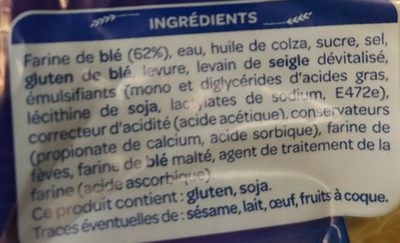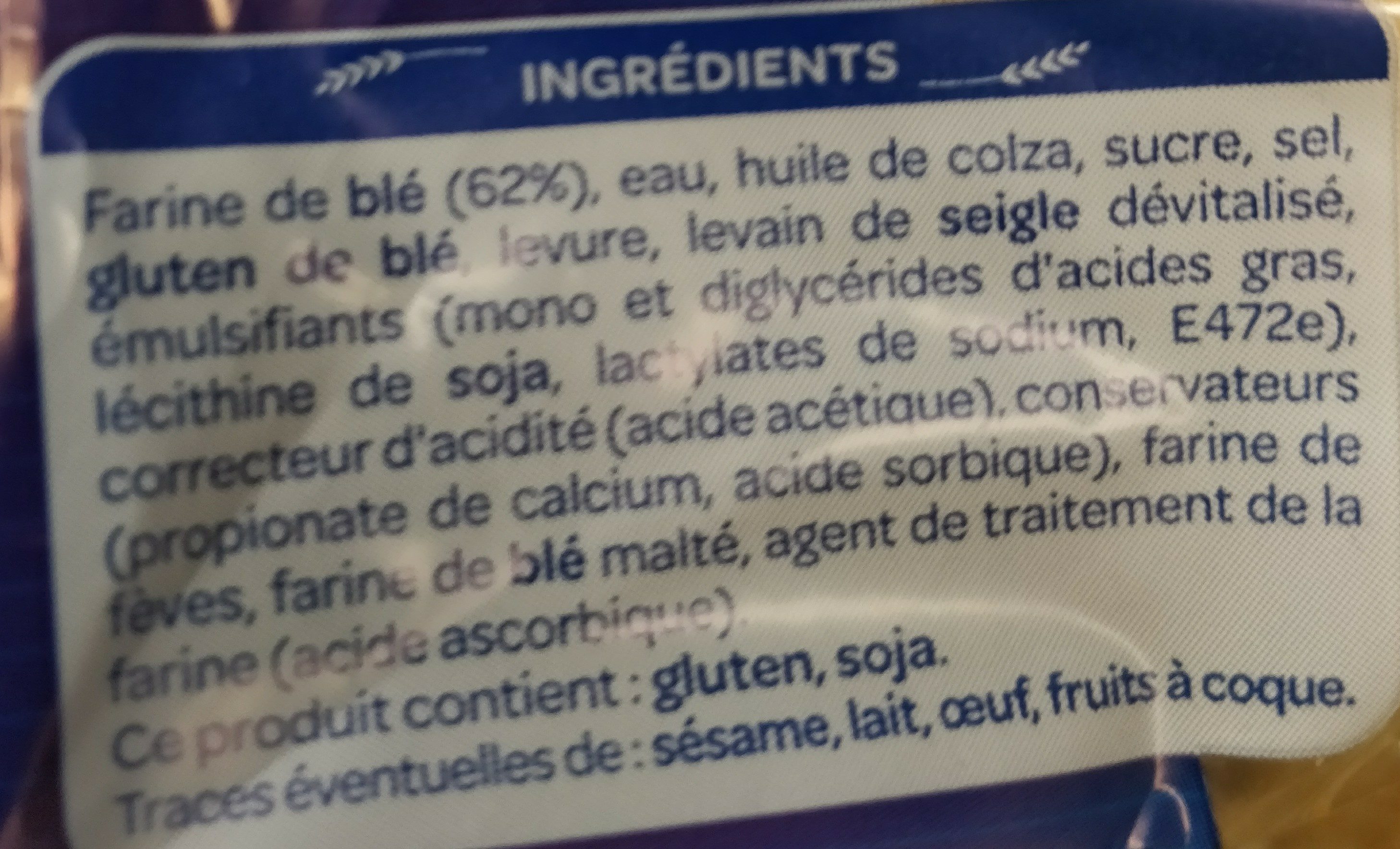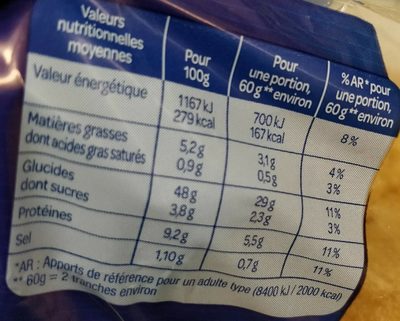Help us make food transparency the norm!
As a non-profit organization, we depend on your donations to continue informing consumers around the world about what they eat.
The food revolution starts with you!
Pain de Mie - St Rolan - 455 g
Pain de Mie - St Rolan - 455 g
This product page is not complete. You can help to complete it by editing it and adding more data from the photos we have, or by taking more photos using the app for Android or iPhone/iPad. Thank you!
×
Barcode: 3338880000573 (EAN / EAN-13)
Common name: Tranches de pain de mie
Quantity: 455 g
Brands: St Rolan
Categories: Plant-based foods and beverages, Plant-based foods, Cereals and potatoes, Breads, Sliced breads
Labels, certifications, awards: No palm oil
Origin of ingredients: Réunion
Manufacturing or processing places: La Réunion
Matching with your preferences
Health
Ingredients
-
22 ingredients
: Farine de blé (62 %), eau, huile de colza, sucre, sel, gluten de blé, levure, levain de seigle dévitalisé, émulsifiants (mono et diglycérides d'acides gras, lécithine de soja, lactates de sodium, E472e), correcteur d'acidité (acide acétique, conservateurs (propionate de calcium, acide sorbique), farine de fèves, farine de blé malté, agent de traitement de la farine : acide ascorbique.Allergens: Gluten, SoybeansTraces: Eggs, Milk, Nuts, Sesame seeds
Food processing
-
Ultra processed foods
Elements that indicate the product is in the 4 - Ultra processed food and drink products group:
- Additive: E322 - Lecithins
- Additive: E325 - Sodium lactate
- Additive: E471 - Mono- and diglycerides of fatty acids
- Additive: E472e - Mono- and diacetyltartaric acid esters of mono- and diglycerides of fatty acids
- Ingredient: Emulsifier
- Ingredient: Gluten
Food products are classified into 4 groups according to their degree of processing:
- Unprocessed or minimally processed foods
- Processed culinary ingredients
- Processed foods
- Ultra processed foods
The determination of the group is based on the category of the product and on the ingredients it contains.
Additives
-
E200 - Sorbic acid
Sorbic acid: Sorbic acid, or 2‚4-hexadienoic acid, is a natural organic compound used as a food preservative. It has the chemical formula CH3-CH-4CO2H. It is a colourless solid that is slightly soluble in water and sublimes readily. It was first isolated from the unripe berries of the Sorbus aucuparia -rowan tree-, hence its name.Source: Wikipedia
-
E260 - Acetic acid
Acetic acid: Acetic acid , systematically named ethanoic acid , is a colorless liquid organic compound with the chemical formula CH3COOH -also written as CH3CO2H or C2H4O2-. When undiluted, it is sometimes called glacial acetic acid. Vinegar is no less than 4% acetic acid by volume, making acetic acid the main component of vinegar apart from water. Acetic acid has a distinctive sour taste and pungent smell. In addition to household vinegar, it is mainly produced as a precursor to polyvinyl acetate and cellulose acetate. It is classified as a weak acid since it only partially dissociates in solution, but concentrated acetic acid is corrosive and can attack the skin. Acetic acid is the second simplest carboxylic acid -after formic acid-. It consists of a methyl group attached to a carboxyl group. It is an important chemical reagent and industrial chemical, used primarily in the production of cellulose acetate for photographic film, polyvinyl acetate for wood glue, and synthetic fibres and fabrics. In households, diluted acetic acid is often used in descaling agents. In the food industry, acetic acid is controlled by the food additive code E260 as an acidity regulator and as a condiment. In biochemistry, the acetyl group, derived from acetic acid, is fundamental to all forms of life. When bound to coenzyme A, it is central to the metabolism of carbohydrates and fats. The global demand for acetic acid is about 6.5 million metric tons per year -Mt/a-, of which approximately 1.5 Mt/a is met by recycling; the remainder is manufactured from methanol. Vinegar is mostly dilute acetic acid, often produced by fermentation and subsequent oxidation of ethanol.Source: Wikipedia
-
E282 - Calcium propionate
Calcium propanoate: Calcium propanoate or calcium propionate has the formula Ca-C2H5COO-2. It is the calcium salt of propanoic acid.Source: Wikipedia
-
E322 - Lecithins
Lecithins are natural compounds commonly used in the food industry as emulsifiers and stabilizers.
Extracted from sources like soybeans and eggs, lecithins consist of phospholipids that enhance the mixing of oil and water, ensuring smooth textures in various products like chocolates, dressings, and baked goods.
They do not present any known health risks.
-
E322i - Lecithin
Lecithins are natural compounds commonly used in the food industry as emulsifiers and stabilizers.
Extracted from sources like soybeans and eggs, lecithins consist of phospholipids that enhance the mixing of oil and water, ensuring smooth textures in various products like chocolates, dressings, and baked goods.
They do not present any known health risks.
-
E325 - Sodium lactate
Sodium lactate: Sodium lactate is the sodium salt of lactic acid, and has a mild saline taste. It is produced by fermentation of a sugar source, such as corn or beets, and then, by neutralizing the resulting lactic acid to create a compound having the formula NaC3H5O3.Source: Wikipedia
-
E471 - Mono- and diglycerides of fatty acids
Mono- and diglycerides of fatty acids (E471), are food additives commonly used as emulsifiers in various processed foods.
These compounds consist of glycerol molecules linked to one or two fatty acid chains, which help stabilize and blend water and oil-based ingredients. E471 enhances the texture and shelf life of products like margarine, baked goods, and ice cream, ensuring a smooth and consistent texture.
It is generally considered safe for consumption within established regulatory limits.
Ingredients analysis
-
May contain palm oil
Ingredients that may contain palm oil: E471, E472e
-
Vegan status unknown
Unrecognized ingredients: fr:Levain de seigle dévitalisé
-
Vegetarian status unknown
Unrecognized ingredients: fr:Levain de seigle dévitalisé
-
Details of the analysis of the ingredients
: Farine de _blé_ 62%, eau, huile de colza, sucre, sel, _gluten de blé_, levure, levain de _seigle_ dévitalisé, émulsifiants (mono- et diglycérides d'acides gras, lécithine de soja, lactates de sodium, e472e), correcteur d'acidité, acide acétique, conservateurs (propionate de calcium, acide sorbique), farine de fèves, farine de _blé_ malté, agent de traitement de la farine (acide ascorbique)- Farine de _blé_ -> en:wheat-flour - vegan: yes - vegetarian: yes - ciqual_proxy_food_code: 9410 - percent_min: 62 - percent: 62 - percent_max: 62
- eau -> en:water - vegan: yes - vegetarian: yes - ciqual_food_code: 18066 - percent_min: 2.71428571428571 - percent_max: 38
- huile de colza -> en:colza-oil - vegan: yes - vegetarian: yes - from_palm_oil: no - ciqual_food_code: 17130 - percent_min: 0 - percent_max: 33.3333333333333
- sucre -> en:sugar - vegan: yes - vegetarian: yes - ciqual_proxy_food_code: 31016 - percent_min: 0 - percent_max: 3.8
- sel -> en:salt - vegan: yes - vegetarian: yes - ciqual_food_code: 11058 - percent_min: 0 - percent_max: 1.1
- _gluten de blé_ -> en:wheat-gluten - vegan: yes - vegetarian: yes - percent_min: 0 - percent_max: 1.1
- levure -> en:yeast - vegan: yes - vegetarian: yes - percent_min: 0 - percent_max: 1.1
- levain de _seigle_ dévitalisé -> fr:levain-de-seigle-devitalise - percent_min: 0 - percent_max: 1.1
- émulsifiants -> en:emulsifier - percent_min: 0 - percent_max: 1.1
- mono- et diglycérides d'acides gras -> en:e471 - vegan: maybe - vegetarian: maybe - from_palm_oil: maybe - percent_min: 0 - percent_max: 1.1
- lécithine de soja -> en:soya-lecithin - vegan: yes - vegetarian: yes - ciqual_food_code: 42200 - percent_min: 0 - percent_max: 0.55
- lactates de sodium -> en:e325 - vegan: yes - vegetarian: yes - percent_min: 0 - percent_max: 0.366666666666667
- e472e -> en:e472e - vegan: maybe - vegetarian: maybe - from_palm_oil: maybe - percent_min: 0 - percent_max: 0.275
- correcteur d'acidité -> en:acidity-regulator - percent_min: 0 - percent_max: 1.1
- acide acétique -> en:e260 - vegan: yes - vegetarian: yes - percent_min: 0 - percent_max: 1.1
- conservateurs -> en:preservative - percent_min: 0 - percent_max: 1.1
- propionate de calcium -> en:e282 - vegan: yes - vegetarian: yes - percent_min: 0 - percent_max: 1.1
- acide sorbique -> en:e200 - vegan: yes - vegetarian: yes - percent_min: 0 - percent_max: 0.55
- farine de fèves -> en:broad-bean-flour - vegan: yes - vegetarian: yes - ciqual_proxy_food_code: 9410 - percent_min: 0 - percent_max: 1.1
- farine de _blé_ malté -> en:malted-wheat-flour - vegan: yes - vegetarian: yes - ciqual_proxy_food_code: 9410 - percent_min: 0 - percent_max: 1.1
- agent de traitement de la farine -> en:flour-treatment-agent - percent_min: 0 - percent_max: 1.1
- acide ascorbique -> en:e300 - vegan: yes - vegetarian: yes - percent_min: 0 - percent_max: 1.1
Nutrition
-
Good nutritional quality
⚠ ️Warning: the amount of fiber is not specified, their possible positive contribution to the grade could not be taken into account.⚠ ️Warning: the amount of fruits, vegetables and nuts is not specified on the label, it was estimated from the list of ingredients: 8This product is not considered a beverage for the calculation of the Nutri-Score.
Positive points: 5
- Proteins: 5 / 5 (value: 9.2, rounded value: 9.2)
- Fiber: 0 / 5 (value: 0, rounded value: 0)
- Fruits, vegetables, nuts, and colza/walnut/olive oils: 0 / 5 (value: 8.82142857142857, rounded value: 8.8)
Negative points: 7
- Energy: 3 / 10 (value: 1167, rounded value: 1167)
- Sugars: 0 / 10 (value: 3.8, rounded value: 3.8)
- Saturated fat: 0 / 10 (value: 0.9, rounded value: 0.9)
- Sodium: 4 / 10 (value: 440, rounded value: 440)
The points for proteins are counted because the negative points are less than 11.
Nutritional score: (7 - 5)
Nutri-Score:
-
Nutrient levels
-
Fat in moderate quantity (5.2%)
What you need to know- A high consumption of fat, especially saturated fats, can raise cholesterol, which increases the risk of heart diseases.
Recommendation: Limit the consumption of fat and saturated fat- Choose products with lower fat and saturated fat content.
-
Saturated fat in low quantity (0.9%)
What you need to know- A high consumption of fat, especially saturated fats, can raise cholesterol, which increases the risk of heart diseases.
Recommendation: Limit the consumption of fat and saturated fat- Choose products with lower fat and saturated fat content.
-
Sugars in low quantity (3.8%)
What you need to know- A high consumption of sugar can cause weight gain and tooth decay. It also augments the risk of type 2 diabetes and cardio-vascular diseases.
Recommendation: Limit the consumption of sugar and sugary drinks- Sugary drinks (such as sodas, fruit beverages, and fruit juices and nectars) should be limited as much as possible (no more than 1 glass a day).
- Choose products with lower sugar content and reduce the consumption of products with added sugars.
-
Salt in moderate quantity (1.1%)
What you need to know- A high consumption of salt (or sodium) can cause raised blood pressure, which can increase the risk of heart disease and stroke.
- Many people who have high blood pressure do not know it, as there are often no symptoms.
- Most people consume too much salt (on average 9 to 12 grams per day), around twice the recommended maximum level of intake.
Recommendation: Limit the consumption of salt and salted food- Reduce the quantity of salt used when cooking, and don't salt again at the table.
- Limit the consumption of salty snacks and choose products with lower salt content.
-
-
Nutrition facts
Nutrition facts As sold
for 100 g / 100 mlAs sold
per serving (60 g)Compared to: Sliced breads Energy 1,167 kj
(279 kcal)700 kj
(167 kcal)+7% Fat 5.2 g 3.12 g +28% Saturated fat 0.9 g 0.54 g +40% Carbohydrates 48 g 28.8 g +8% Sugars 3.8 g 2.28 g -8% Fiber ? ? Proteins 9.2 g 5.52 g +4% Salt 1.1 g 0.66 g - Fruits‚ vegetables‚ nuts and rapeseed‚ walnut and olive oils (estimate from ingredients list analysis) 8.821 % 8.821 %
Environment
-
Eco-Score B - Low environmental impact
⚠ ️Select a country in order to include the full impact of transportation.The Eco-Score is an experimental score that summarizes the environmental impacts of food products.→ The Eco-Score was initially developped for France and it is being extended to other European countries. The Eco-Score formula is subject to change as it is regularly improved to make it more precise and better suited to each country.Life cycle analysis
-
Average impact of products of the same category: A (Score: 90/100)
Category: Sandwich loaf
Category: Sandwich loaf
- PEF environmental score: 0.19 (the lower the score, the lower the impact)
- including impact on climate change: 1.76 kg CO2 eq/kg of product
Stage Impact Agriculture
58.9 %Processing
23.6 %Packaging
12.2 %Transportation
4.8 %Distribution
0.4 %Consumption
0.0 %
Bonuses and maluses
-
Origins of ingredients with a high impact
Malus: 0
Environmental policy: 0
Transportation: 0
Origin of the product and/or its ingredients % of ingredients Impact Réunion 100 %High
-
Packaging with a medium impact
Malus: -10
Shape Material Recycling Impact Bag Plastic High
Eco-Score for this product
-
Impact for this product: B (Score: 79/100)
Product: Pain de Mie - St Rolan - 455 g
Life cycle analysis score: 90
Sum of bonuses and maluses: -10
Final score: 79/100 (The score of products with non-recyclable and non-biodegradable packaging materials is capped at 79 (grade B).)
-
Carbon footprint
-
Equal to driving 0.9 km in a petrol car
176 g CO² per 100g of product
The carbon emission figure comes from ADEME's Agribalyse database, for the category: Sandwich loaf (Source: ADEME Agribalyse Database)
Stage Impact Agriculture
59.3 %Processing
17.8 %Packaging
16.0 %Transportation
6.7 %Distribution
0.3 %Consumption
0.0 %
Packaging
-
Packaging with a medium impact
-
Packaging parts
Bag (Plastic)
-
Packaging materials
Material % Packaging weight Packaging weight per 100 g of product Plastic
-
Transportation
-
Origins of ingredients
Origins of ingredients with a high impact
Origin of the product and/or its ingredients % of ingredients Impact Réunion 100 %High
Report a problem
-
Incomplete or incorrect information?
Category, labels, ingredients, allergens, nutritional information, photos etc.
If the information does not match the information on the packaging, please complete or correct it. Open Food Facts is a collaborative database, and every contribution is useful for all.
Data sources
Product added on by hassan
Last edit of product page on by packbot.
Product page also edited by beniben, kiliweb, openfoodfacts-contributors, tacite, yuka.UVB3eENxczhwZU1LbnNjRC95S0xwTjVZM3FPVlhEK3NCY1E4SVE9PQ.










